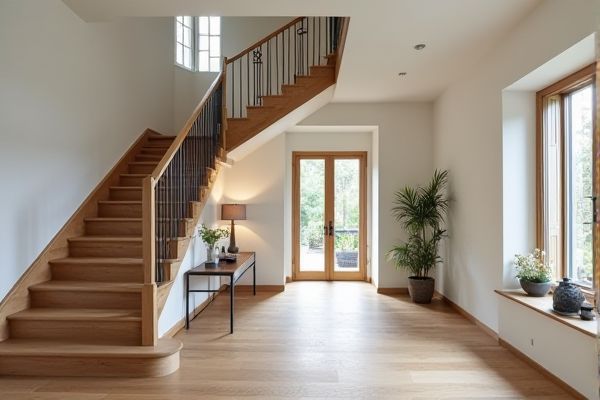
Contemporary staircases feature sleek designs, often utilizing materials like glass, metal, and open risers to create a minimalist and airy feel, while traditional staircases emphasize classic craftsmanship with wood, ornate balusters, and closed risers for a warm, timeless look. Explore the rest of the article to discover which style perfectly suits your home's aesthetic and functional needs.
Table of Comparison
| Feature | Contemporary Staircase | Traditional Staircase |
|---|---|---|
| Design Style | Minimalist, sleek, modern materials | Ornate, classic, wooden craftsmanship |
| Materials | Glass, metal, concrete | Wood, wrought iron, stone |
| Color Palette | Neutral, monochrome, bold contrasts | Warm tones, natural wood finishes |
| Space Utilization | Open, maximizes light and space | Enclosed, solid and substantial |
| Safety Features | Tempered glass panels, sleek railings | Sturdy banisters, traditional balusters |
| Maintenance | Low-maintenance, easy to clean | Regular polishing, upkeep required |
| Installation | Custom fabrication, modern techniques | Standardized, handcrafted |
| Cost | Moderate to high, depending on materials | Varies, often lower for basic designs |
| Popular Usage | Modern homes, commercial spaces | Classic homes, heritage properties |
Introduction: Defining Contemporary and Traditional Staircases
Contemporary staircases emphasize clean lines, minimalism, and innovative materials such as glass, steel, and concrete, reflecting modern architectural trends. Traditional staircases feature classic designs with ornate details, wood finishes, and curved balusters that evoke timeless elegance. Your choice between these styles shapes the overall aesthetic and functionality of your living space.
Key Design Principles
Contemporary staircases emphasize minimalism, clean lines, and often incorporate materials like glass, steel, and concrete to create an open, airy feel that complements modern interiors. Traditional staircases prioritize craftsmanship with ornate details, wood finishes, and classic shapes such as curved or spiral designs, reflecting timeless elegance and warmth. Choosing your staircase design involves considering these key principles to align your space's aesthetic with functionality and style preferences.
Materials Used: Modern vs. Classic Choices
Contemporary staircases often utilize materials like glass, steel, and concrete, emphasizing sleek, minimalistic designs that highlight transparency and industrial aesthetics. Traditional staircases typically feature wood, wrought iron, and brass, offering warmth and intricate craftsmanship reflecting classic architectural styles. The choice of materials fundamentally influences the staircase's visual appeal, structural integrity, and compatibility with overall interior design themes.
Aesthetic Appeal and Visual Impact
Contemporary staircases feature sleek lines, minimalistic designs, and materials like glass, steel, and concrete, creating a bold visual impact that complements modern interiors. Traditional staircases emphasize ornate details, rich wood tones, and classic balustrades, offering a warm, timeless aesthetic with intricate craftsmanship. The contrast between contemporary's clean simplicity and traditional's decorative elegance defines each style's unique contribution to a home's overall atmosphere.
Space Utilization and Layout
Contemporary staircases prioritize space utilization with sleek, open designs such as floating treads and minimalistic railings, allowing light to flow and visually expanding smaller areas. Traditional staircases often feature bulkier structures with closed risers and ornamental balusters, consuming more space and creating defined, segmented layouts. Optimizing layout in contemporary stairs enhances functional flow, making them ideal for modern, compact living environments where maximizing usable space is critical.
Safety Features and Building Codes
Contemporary staircases incorporate advanced safety features such as anti-slip treads, integrated LED lighting, and modern handrail designs that comply with updated building codes. Traditional staircases often rely on classic balustrades and standard tread dimensions, which may not fully meet newer safety regulations. Understanding these differences ensures your staircase aligns with current standards for safety and functionality.
Maintenance and Durability
Contemporary staircases often use modern materials like steel, glass, and engineered wood, which offer enhanced durability and require less frequent maintenance compared to traditional staircases made from solid wood or wrought iron. The sleek finishes and protective coatings in contemporary designs resist scratches, moisture, and wear, reducing the need for refinishing or repairs. Traditional staircases may demand regular polishing, sealing, or rust prevention to maintain their appearance and structural integrity over time.
Cost Comparison and Budget Considerations
Contemporary staircases often feature sleek materials like glass, steel, and engineered wood, typically resulting in higher installation costs compared to traditional staircases made from solid wood and classic designs. Traditional staircases benefit from readily available materials and established construction methods, making them more budget-friendly for homeowners. Your choice between these styles should consider long-term value, design preferences, and overall project budget constraints.
Popular Trends in Staircase Design
Contemporary staircases emphasize sleek lines, minimalistic materials such as glass and metal, and open risers to create an airy, modern aesthetic that maximizes light and space. Traditional staircases often feature classic elements like wooden balusters, detailed moldings, and closed risers, preserving a sense of warmth and craftsmanship. Your choice between these popular trends can define the overall style and atmosphere of your home, balancing modern elegance with classic charm.
Choosing the Right Staircase for Your Home
Contemporary staircases feature sleek lines, minimalist design, and materials like glass, steel, or concrete, enhancing modern homes with an open and airy feel. Traditional staircases often include wood craftsmanship, ornate details, and classic balusters, providing warmth and timeless elegance. Selecting the right staircase depends on your home's architectural style, space availability, and personal design preferences to ensure both functionality and aesthetic harmony.
 homyna.com
homyna.com